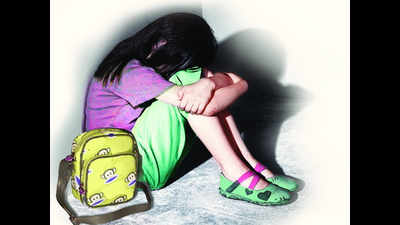- News
- City News
- delhi News
- 1 in 5 kids in rehab homes has behavioural issues, finds study
Trending
This story is from May 19, 2018
1 in 5 kids in rehab homes has behavioural issues, finds study

Representative Image
NEW DELHI: The poor mental health of many inmates of child rehabilitation institutions in Delhi has always been known. But it is only now that there are actual figures to show the extent of a brewing crisis as the children grow older. The data has been collated by the psychiatry department of All India Institute of Medical Sciences, based on its assessment of 414 children living in 19 children’s homes and observation homes run by the government and NGOs in the capital.

Published last week by the National Commission for Protection of Child Rights (NCPCR), the data shows that almost one of every five inmates in such institutions suffers from behavioural problems. This makes them highly susceptible to substance abuse or criminal activities when they reach adulthood. Almost 2% of them also suffer from psychiatric disorders.
The situation in observation homes, which house juveniles accused of criminal activities, is worse. Here, the AIIMS doctors reported that 74% of the inmates have behavioural problems and 2% suffer from some sort of psychiatric disorder.
The report, a copy of which is with TOI, says most children’s homes did not have a full-time or qualified mental health professional, thought Rule 46 of the Delhi Juvenile Justice Rules, 2009, provides for maintenance of the mental health record of every child by the institution as well as interventions and individual therapy for every child.
The researchers found that mental health assessment of inmates in most homes was poorly detailed and did not follow the prescribed scheme for such examinations. “Only in institutes where a child had a grossly identifiable mental illness was there was a follow-up record of the healthcare plan. Otherwise it was absent,” the report noted. In one of the institutions, the researchers found a Hindi honours graduate employed as a full-time counsellor.
One of the objectives of children’s homes is to help rehabilitate the child, but the AIIMS study found that institutions run by NGOs did little to trace the families of abandoned or missing children, leaving the work entirely to the Delhi Child Welfare Committee. Fortunately, homes run by the government were seen to be actively engaged in establishing the whereabouts of their families jointly with the Child Welfare Committee.
Children reported to the researchers their woes about bullying by seniors and being targeted for homosexual acts in some homes. Other problems included overcrowding, lack of sanitation and unspecified nutrition plans. Some of the caregivers also complained about being overburdened.
A child rights activist was happy with the AIIMS report undertaken on behalf of NCPCR. “There are an estimated two lakh children living in 5,000 observation centres and children’s homes in the country. Similar assessments should be carried everywhere and interventions planned to save children from a mentally insecure future,” said the activist. Team head Sagar said there were indeed plans to emulate similar assessment in childcare institutions across the country.

Published last week by the National Commission for Protection of Child Rights (NCPCR), the data shows that almost one of every five inmates in such institutions suffers from behavioural problems. This makes them highly susceptible to substance abuse or criminal activities when they reach adulthood. Almost 2% of them also suffer from psychiatric disorders.
The situation in observation homes, which house juveniles accused of criminal activities, is worse. Here, the AIIMS doctors reported that 74% of the inmates have behavioural problems and 2% suffer from some sort of psychiatric disorder.
Dr Rajesh Sagar, who led the investigation, told TOI that children suffering from behavioural problems require medical attention and counselling. “If left on their own, they can develop conduct problems and will be prone to substance abuse and criminal activities when they grow up,” Sagar said.
The report, a copy of which is with TOI, says most children’s homes did not have a full-time or qualified mental health professional, thought Rule 46 of the Delhi Juvenile Justice Rules, 2009, provides for maintenance of the mental health record of every child by the institution as well as interventions and individual therapy for every child.
The researchers found that mental health assessment of inmates in most homes was poorly detailed and did not follow the prescribed scheme for such examinations. “Only in institutes where a child had a grossly identifiable mental illness was there was a follow-up record of the healthcare plan. Otherwise it was absent,” the report noted. In one of the institutions, the researchers found a Hindi honours graduate employed as a full-time counsellor.
One of the objectives of children’s homes is to help rehabilitate the child, but the AIIMS study found that institutions run by NGOs did little to trace the families of abandoned or missing children, leaving the work entirely to the Delhi Child Welfare Committee. Fortunately, homes run by the government were seen to be actively engaged in establishing the whereabouts of their families jointly with the Child Welfare Committee.
Children reported to the researchers their woes about bullying by seniors and being targeted for homosexual acts in some homes. Other problems included overcrowding, lack of sanitation and unspecified nutrition plans. Some of the caregivers also complained about being overburdened.
A child rights activist was happy with the AIIMS report undertaken on behalf of NCPCR. “There are an estimated two lakh children living in 5,000 observation centres and children’s homes in the country. Similar assessments should be carried everywhere and interventions planned to save children from a mentally insecure future,” said the activist. Team head Sagar said there were indeed plans to emulate similar assessment in childcare institutions across the country.
End of Article
FOLLOW US ON SOCIAL MEDIA










